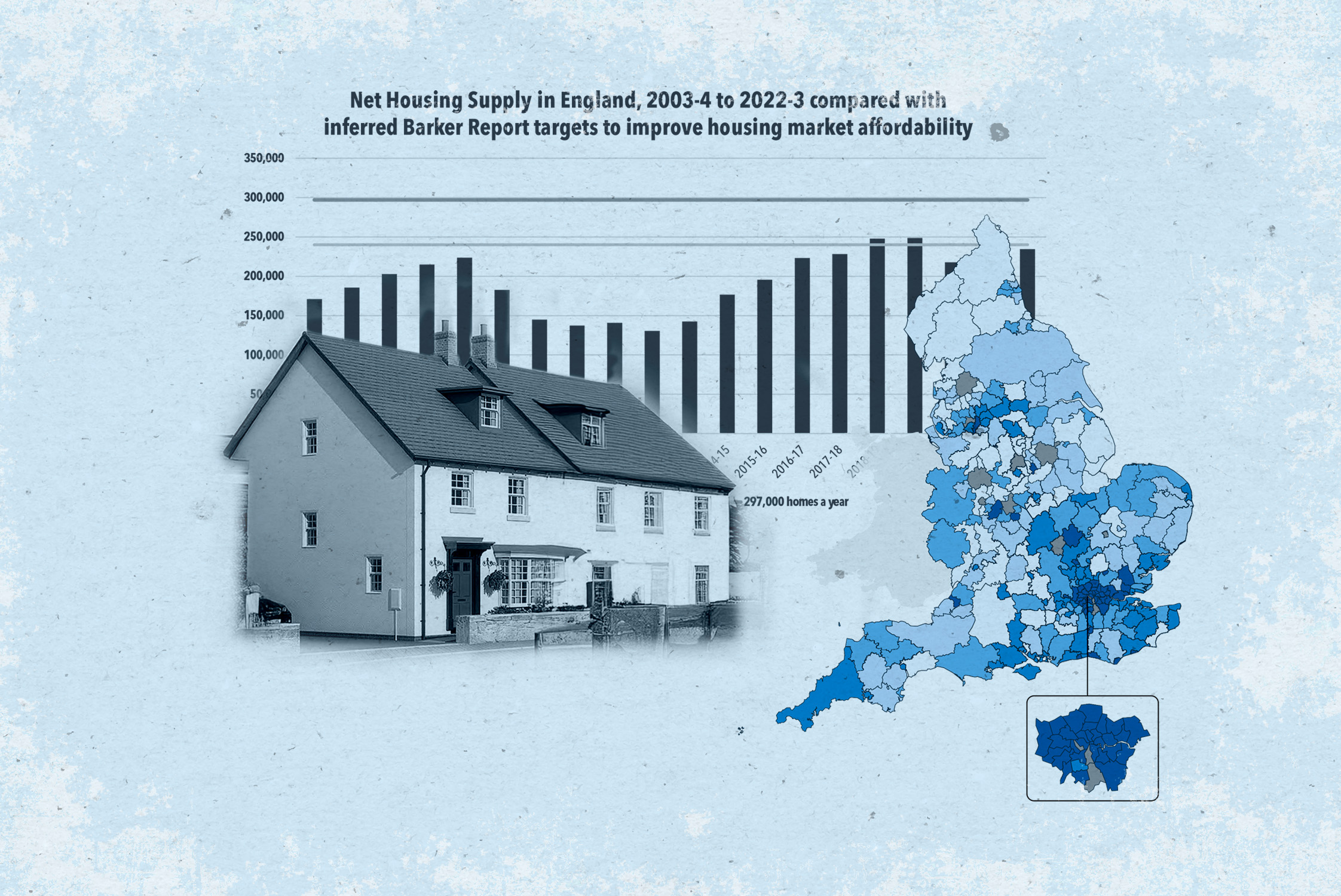The master plan
Communities secretary Eric Pickles is leading the overhaul of the planning system. So will the new strategies deliver? Ahead of the Conservative Party conference Jules Birch gathers a team of experts to find out.

It’s the issue that has set Conservative against Conservative and left ministers battling against a powerful partnership between the National Trust and The Daily Telegraph.
Yet the national planning policy framework and its controversial ‘presumption in favour of sustainable development’ - which some campaigners claim is akin to giving the green light to concrete over the courtryside - are just part of the wider overhaul of the planning system for new housing in England by communities secretary Eric Pickles.
Alongside the NPPF, other key reforms are: land auctions, commercial to residential conversions, the new homes bonus and localism, which brings with it the development of neighbourhood plans.
The reforms in the Localism Bill aim to replace Labour’s top-down regional strategies with bottom-up incentives for communities to agree to development to generate new homes and economic growth. But will they deliver?
As part of Inside Housing’s Get on our Land campaign, which calls for land to be made available for development, and before the debate no doubt rages on at the Tory party conference, beginning on Sunday, we asked six experts for their verdict on the potential of these five key reforms. How likely are they to bring development sites forward and deliver new homes?
What’s the verdict?
Each expert has given the reforms a mark out of 10. These scores have then been combined to give an overall percentage verdict of likely success.
Our experts stress the importance of viewing the package of reforms as a whole - something the government itself doesn’t seem to be doing, according to Karen Cooksley, head of planning at law firm Winckworth Sherwood. ‘The media has been focusing on the debate about the NPPF as though it is the legislation when of course it’s not; it’s the policy that fits under the legislation in the Localism Bill,’ she says.
Ian Tant, senior partner at planning consultancy Barton Willmore, thinks ‘a lot of people believed what they read in the press last year that localism was about handing controls back to local people, generally interpreted as an ability to stop development’. Much of the reaction to the NPPF is, he says, ‘about people realising they are not being offered the chance to say no to development, but the chance to say where it takes place’.

National planning policy framework
What’s the big idea?
The National planning policy framework radically simplifies current planning guidance and includes a ‘presumption in favour of sustainable development’ where local authorities have not agreed a local plan.
Last week there was a change in tone from the government in the form of a letter of reassurance from prime minister David Cameron to the National Trust, a vocal critic of the NPPF. In it he wrote that sustainable development meant maintaining a balance between economic, environmental and socal concerns.
The experts’ verdict
There was strong support for the NPPF from our experts and a feeling that it has been wildly misrepresented in the media.
‘It’s a brave attempt to simplify the body of planning policy and hopefully educate people that well-planned new development is a good thing,’ says
Greg Mitchell. ‘It’s good to see the government trying to define its approach to sustainable development.’
Objectors have argued that the ‘presumption’ would mean it would be difficult to stop virtually any development since ‘sustainable’ is a vague term and has no legal force. However, Karen Cooksley says this is simply wrong. ‘In the world of planning [the term ‘sustainable’] does have technical and legal force and we are dealing with European and national laws that are drafted to lead you to sustainability, [meaning] meeting the needs of the current generation without depriving the next.’
Andrew Whitaker is positive the NPPF will work. ‘If you take away regional strategies, you have to have some sort of ‘stick’ in there or local authorities will just sit on their hands,’ he says. ‘The presumption in favour of sustainable development is that stick and that’s why it’s important. It forces local authorities to be far more proactive in the planning process and to identify sites that are deliverable.’
However, some doubts remain about the detail of the framework and its real impact in a depressed market. Cameron Watt argues that it’s ‘vital’ the wording of the NPPF is changed so that affordable housing delivery onsite is seen as an ‘essential part of sustainable development and not something that can be negotiated away as the developer wants’.
And Richard Jones, head of residential at construction consultant EC Harris, says the framework might increase the number of sites with planning permission without necessarily improving delivery. ‘It’s an opportunity for house builders to get planning permission in place because the appetite and resources for local authorities to fight them isn’t there. Whether that translates into more homes on the ground remains to be seen because that depends on their ability to sell them.’
Potential for success: 82%
Localism and neighbourhood plans
What’s the big idea?
Localism is central to the government’s pledge to replace Labour’s top-down regional strategies with bottom-up decisions by local communities. The Localism Bill will enable residents to set their own priorities in neighbourhood plans and create a statutory duty for developers to consult local people before they submit planning applications for major schemes.
The experts’ verdict
Our experts were more divided on localism than any other area, with some arguing that it will get people more positively engaged in planning while others see it as a recipe for confusion.
Andrew Whitaker argues that neighbourhood planning will engage the silent majority who will see the benefits of development against the vocal minority of opponents.
But Karen Cooksley warns of ‘inherent contradictions’ in the system that could lead to more judicial reviews in the High Court. ‘There is a danger of people not knowing what the hierarchy is. Does the neighbourhood forum trump the local authority or vice versa?’
And Ian Tant worries localism could hold back development and leave local communities in an awkward position.
‘They may have to choose between landowners they have known all their lives or decide where development goes when they don’t actually want it,’ he says.
Potential for success: 52%
Land auctions
What’s the big idea?
Councils ask landowners to name the price at which they would sell their land and have the right to buy it at that price for the next 18 months. They can then capture any uplift in land values when they come to sell sites to developers after it has been granted planning permission.
The experts’ verdict
In theory, land auctions could be a more powerful incentive for councils and communities to support new homes. However, there are doubts about what difference they will make in practice and how much will really be learned from the public sector land pilots, which chancellor George Osborne announced plans for during his Budget speech in March, but are yet to materialise.
‘It may help but there is no detail,’ says Greg Mitchell. ‘And the devil will be in the detail.’
Andrew Whitaker says his organisation has done a lot of work with Tim Leunig, the London School of Economics academic who developed the idea. ‘We don’t think he has sufficient idea of how much we pay landowners already and how much we pay in section 106,’ he explains.
Potential for success: 34%
New homes bonus
What’s the big idea?
Housing minister Grant Shapps describes this as a powerful incentive for local authorities to agree to new homes. Since April this year the government is matching council tax raised on each new home, or empty property brought back into use, for six years and paying 25 per cent extra for each affordable home.
The experts’ verdict
Our experts like the idea of a direct financial incentive for councils to approve new homes. ‘The problem in the past has been that local authorities faced with new development just see the cost in infrastructure and services,’ says Ian Tant. ‘This could be an important way of improving the public view of new homes.’
However, while there is support for the idea in principle, there are some real doubts about funding, and the way the bonus tends to penalise councils in the north of England, which are more reliant on government funding, at the expense of the south. In February, the National Housing Federation warned that the scheme will favour local authorities in the south because of the higher value of homes in their area. Ministers plan to make up the funding shortfall caused by the £1 billion bonus scheme using money from the local authority formula grant. The NHF estimated that councils in the north will lose around £104 million, while authorities in the south will see a net gain of £324 million.
Cameron Watt points to research entitled Room for improvement, published by Centre for Cities in July, which concludes that the bonus needs to be three times more generous to make a real difference.
Meanwhile, Mr Whitaker says the idea falls down because there is no new money after the first three years, with the rest being top-sliced from existing formula grant paid by central government to local authorities. ‘So it’s not much of a bonus. It’s a good idea but the government should have put more money into it,’ he adds.
Potential for success: 52%
Converting offices into homes
What’s the big idea?
To make it easier to turn thousands of empty offices into homes by allowing change of use from commercial to residential without the need for planning permission. According to a government consultation paper, conversions could generate 260,000 homes over the next 10 years - although civil servants have raised doubts about whether this is achievable.
The experts’ verdict
Potential varies, but many cities have empty offices and industrial buildings in places where people want to live, and councils have traditionally been unwilling to redesignate land with employment uses for housing.
One problem is that changes to the exterior appearance of a building would still need planning permission - and many residential developers will want to change things like floor to ceiling heights and the windows.
Cameron Watt worries that without planning permission there will be no way to get an associated section 106 agreement for the developer to provide affordable housing.
However, Karen Cooksley says this is not insurmountable. ‘It’s not a problem to draft things in such a way that you can change use class without planning permission, but so that section 106 regulations still apply.’
‘The idea is fine but it’s fraught with problems,’ says Ian Tant. ‘It will probably lead to change at the margins because many office buildings either aren’t suitable for conversion to housing without major alterations or they’re in the wrong locations with no access to schools or facilities, but it will not deliver big numbers.’
Potential for success: 44%







